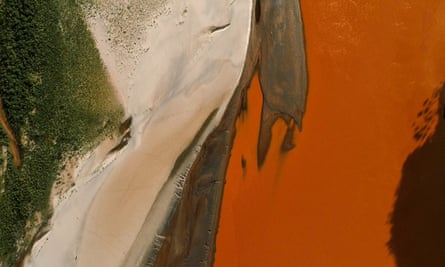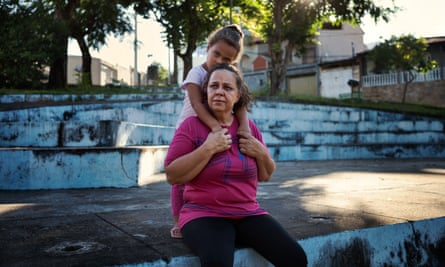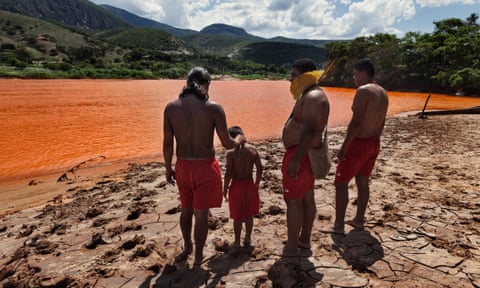Six months before a dam containing millions of litres of mining waste collapsed, killing 19 people in Brazil’s worst environmental disaster, the company operating the mine accurately predicted the potential impact of such a disaster in a worst-case risk assessment.
But federal prosecutors claim the company – a joint venture between the Brazilian mining giant Vale and the Anglo-Australian multinational BHP Billiton – failed to take actions that they say could have prevented the disaster. The prosecutors instead claim the company focused on cutting costs and increasing production.
“They prioritized profits and left safety in second place,” said José Adércio Sampaio, coordinator of a taskforce of federal prosecutors, summarising the criminal case against the joint venture and its parent companies.
When the Fundão tailings dam failed on 5 November 2015, it unleashed about 40m litres of water and sediment from iron ore extraction in a wave that polluted the water supply for hundreds of thousands of people, decimated wildlife and spewed a rust-red plume of mud down the Doce river.
Yet more than two years later, nobody has accepted responsibility.
Previously unreported internal documents from the joint venture Samarco show that six months before the collapse, the company carried out a worst-case assessment of the dam, near Mariana in Minas Gerais state.

The document – one of hundreds submitted to the court by prosecutors – warned that a maximum possible loss from a “liquification break” could mean up to 20 deaths, cause serious impacts to land, water resources and biodiversity over 20 years, and cost $3.4bn.
The prosecutors’ complaint also includes harrowing accounts by survivors from Bento Rodrigues, a small community obliterated by the mud released in the disaster.
Wesley Izabel managed to save his two-year-old son, Nicolas, but his daughter, Emanuelle, five, slipped from his fingers to her death.
When the mud engulfed her house, Darcy Santos heard her grandson Thiago, seven, cry “help me, Jesus!” before he was suffocated.
In 2016, 21 people were charged with qualified homicide, including Samarco’s former CEO and representatives from Vale and BHP Billiton on its board of directors. All the defendants and three companies were also charged with environmental damage.
A separate civil action by prosecutors seeking $48bn in damages was launched in 2016 and is still being negotiated. In January last year, prosecutors and the three companies signed a preliminary deal worth $680m to guarantee recuperation work.
In statements to the Guardian, Samarco, Vale and BHP Billiton said they rejected the charges, that safety had been and remained a priority and that the dam complied with Brazilian legislation. The companies have separately said they would defend their employees and executives.
Separately from the civil action, the three companies made a deal with the federal and state governments in March 2016 to carry out repair, restoration and reconstruction programmes. They have spent more than $1bn on a huge clean-up and relief operation, separate from civil actions launched by prosecutors.
Samarco has also paid about $6.7m in fines levied separately by the state government of Minas Gerais – but none of the 24 fines totalling $105m imposed by the Brazilian government’s environment agency, Ibama.

“Samarco believes there are technical and juridical aspects in the decisions that need to be re-evaluated,” the company said in a statement.
None of the 375 families who lost their homes have yet been rehoused.
“It is a lot of injustice,” said Sandra Quintão, 45, whose small restaurant in Bento Rodrigues was swallowed by the mud.
Until the disaster, Samarco was a Brazilian success story. In 2014, despite falling international iron prices, it declared a net profit of $1.3bn.
But prosecutors allege that its directors encouraged the company to keep cutting costs.

According to minutes from an August 2015 board meeting, which were included in the legal proceedings, company directors said: “Despite the improvements in cost reduction the world is not standing still and further improvements are needed.”
The importance of safety was also stressed at board meetings. At a meeting in August 2012, the board praised Samarco’s safety performance and said the company should “maintain its focus on eliminating fatal risks”.
Prosecutors say that the Fundão tailings dam, one of several huge earthworks built to store iron ore mining waste, had always been problematic.
“The dam had been giving problems year after year,” claimed Sampaio, the prosecutor.
Almost as soon as it started operating in 2008, the dam presented problems with its drainage system and signs of erosion, according to photographs and inspection reports included in court documents.
Samarco lowered the reservoir, changed the drainage system and embarked on a series of remedial works.
After the disaster, Samarco, Vale and BHP Billiton commissioned an investigation by the international law firm Cleary Gottlieb Steen & Hamilton (CGSH). Published in August 2016, it found that construction flaws had damaged the dam’s original drainage system and described attempts to correct the problems.
The report also pointed to three small seismic shocks in the area about 90 minutes before the dam failed. “This additional movement is likely to have accelerated the failure process that was already well advanced,” it said.
The CGSH report did not apportion any blame and Samarco said it would not comment on it. Many of the issues it described are also included in the prosecutors’ complaint.
Seepage, saturation and cracking were seen at the dam in 2013, and again in August 2014, the report said. Samarco reinforced the dam with a berm.

A month later, Joaquim Pimenta de Ávila, a consultant who had previously carried out work for Samarco, reported that “static liquefaction could be present”, documents show. He inspected the area in December 2014 and told prosecutors he had informed Samarco the situation “was not under control”.
Samarco continued raising the height of the dam. According to the CGSH report, this was done in part to enable the company to correct drainage problems.
In separate responses to the Guardian, all three companies denied the prosecutors’ charges.
Samarco did not respond to questions on the dam’s problems, its failure and the risk assessment. In a statement, it said prosecutors had “disregarded the defences and testimonies presented during investigations”, which it said “prove that Samarco did not have any previous knowledge of the risk to its structures”.
BHP Billiton, which owns half of Samarco, said in an email: “We have no reason to believe BHP people knew the dam was at risk of failing. BHP and its representatives will defend these charges.”
Vale, which owns the other half of the joint venture, said in an email that it “repudiates vehemently the complaint presented by prosecutors because innumerable pieces of evidence and testimony presented in the case files that proved that Vale was never responsible for the operational management of the Fundão dam were disrespected”. Vale said: “Board members were always expressly assured of the regularity of the structures.”
According to minutes included in court documents, Samarco’s board of directors, which included representatives of Vale and BHP Billiton, was briefed several times between 2009 and 2014 on the dam’s construction problems and efforts to fix it.
Minutes for all of these meetings – included in court documents – state that representatives from all three companies attended.
At the time of the disaster, the Fundão dam was fitted with devices used to measure liquid pressure and water level, but according to the prosecutors’ case, several were either not working, lacked batteries or had been moved to another dam. Samarco declined to comment on this.

There was no warning siren. When the dam broke, residents were warned by telephone calls or – in Quintão’s case – by a neighbour who roared up on a motorbike shouting: “The dam has burst!”
Samarco said that at the time of the disaster, sirens were not legally required.
The court case, which is being heard in the town of Ponte Nova, is in its preliminary stage and the judge is yet to decide whether it will be heard by a jury.
It was suspended in July after the former Samarco CEO Ricardo Vescovi and another defendant complained that wiretaps were recorded outside of the investigation period, and that the inclusion as evidence of corporate emails and chats invaded their privacy.
The case resumed in November, after the judge decided that corporate emails and chats could not be included and ruled to separate out the cases involving foreign defendants.
Samarco and its owners are keen to return to production. In December, Samarco was given preliminary licences by the Minas Gerais state government’s environment agency for a new reject storage system at the plant.
President Michel Temer’s business-friendly government wants to increase mining, even in sensitive areas like the Amazon, and make environmental licensing more flexible.
